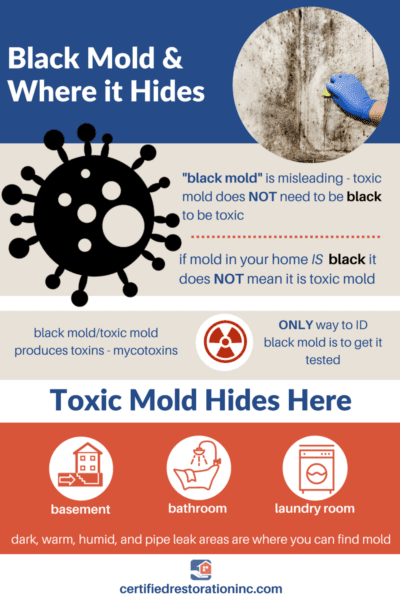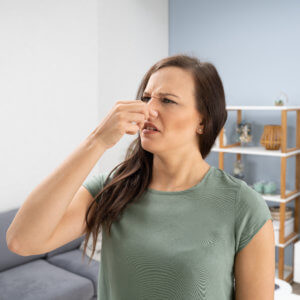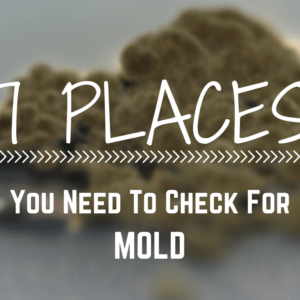For many homeowners or property owners, seeing black mold’s telltale black specks in their space can be the start of a nightmarish situation. Black mold, sometimes known as “toxic mold,” can reveal a whole host of problems underneath the surface of your property. Not only that, but black mold is known to cause a range of severe health hazards to humans and is notoriously difficult to identify and clean properly. In this article, we’ll give you an overview of how to deal with black mold within your property. In summary, this article will discuss the following points:
- Black mold can cause serious health hazards to humans and can be challenging to clean properly.
- Black mold typically grows on household materials like drywall, carpet, insulation, or sub-flooring. It commonly appears in warm, damp, and humid areas of the home, including basements, crawlspaces, bathrooms, and laundry rooms.
- The leading cause of moisture that feeds black mold is water damage caused by leaks, condensation, and flooding.
- Symptoms of exposure to black mold can range from allergy-like symptoms like skin and eye irritation, stuffy nose, and difficulty breathing to serious neurological problems.
- Calling a professional is your best bet for safe and effective black mold removal.
What is black mold?

Black mold, also known as ‘toxic black mold’ or Stachybotrys chartarum is a type of fungus that can produce toxins and cause a wide range of immune system reactions and health problems in humans. It typically grows on household materials that have been exposed to moisture and contain organic matter, such as drywall, carpet, insulation, or sub-flooring. The leading causes of black mold causing moisture are water damage, water leaks, condensation, water infiltration, or flooding. Essentially, black mold must have a constant supply of moisture to grow, so an undetected leak in your home is its favorite food supply.
Just because black-colored mold is found in your home, does not mean it’s the notorious black mold. The word “black” is a little misleading. This variety of toxic mold does not necessarily need to be black in color, it can range in color from greenish-black to gray, to brown.
How to Identify Black Mold
Stachybotrys, or black mold, is dark in color and typically has a musty, earthy scent. This type of mold typically grows in rings and can sometimes have flecks of orange or white interspersed throughout the affected area. Most of the time, black mold has a slightly furry appearance. If the mold growing in your home checks these boxes, call a professional. The only true way to know if the mold growing in your property is Stachybotrys is to get it tested by a professional.
You can get your home tested for mold through an environmental testing company. Mold testing typically involves a technician coming to your home and taking air and surface samples, which are then analyzed in a lab to determine if mold spore levels indicate a risk. Then, you’ll be given recommendations on what is to be done, and a restoration company can be brought in if necessary.
Where does black mold appear?
 Generally, toxic mold will appear in areas of the home that are warm, damp, or humid. Areas susceptible to moisture are usually towards the lower portions of the home, such as basements or crawl spaces that may have small leaks from water sources. Black mold may also occur in bathrooms that are not well-ventilated or in laundry rooms if a leak occurs.
Generally, toxic mold will appear in areas of the home that are warm, damp, or humid. Areas susceptible to moisture are usually towards the lower portions of the home, such as basements or crawl spaces that may have small leaks from water sources. Black mold may also occur in bathrooms that are not well-ventilated or in laundry rooms if a leak occurs.
An unexpected place where black mold often appears is in HVAC systems. Air conditioning units and vents are often dark and have plenty of dust, which provides the organic matter that mold needs to thrive. Add in moisture, and you’ve got the perfect conditions for mold. Mold in HVAC systems is often overlooked because it typically grows on internal components. However, these are among the most dangerous places for mold to grow, as air traveling through the vents can help distribute mold spores and hasten allergic reactions.
What are the health risks of black mold?
Black mold can cause many serious health hazards. There are numerous negative health effects from mold exposure, such as mental impairment, breathing problems, internal organ damage, and in a few serious cases, even death. Learn about the health hazards of black mold in this short video, or read on to discover the risks of black mold exposure.
The symptoms of black mold exposure can be separated into different groups depending upon the area affected by mold presence.
Mental and Neurological Symptoms
Black mold produces toxins that can kill neurons in the brain and can impair a person’s mental faculties. Exposure to black mold toxins may cause mental & neurological conditions, like nervous disorders. Symptoms of mental & neurological effects of black mold exposure include altered behavior, mood swings, and irritability. In addition, symptoms include:
- Confusion
- Short attention span
- Anxiety
- Depression
- Dizziness
- Disorientation
- Difficulty concentrating
Respiratory Symptoms

If left untreated, black mold can seriously affect indoor air quality. Mold spores and mycotoxins can wreak havoc when ingested and have the potential to cause irritation and a burning sensation in air passages, such as the nasal cavity, mouth, and throat.
Some common symptoms of respiratory issues from black mold exposure include:
- Difficulty breathing (shortness of breath)
- Asthma attacks
- Nose bleeds
- Sneezing
- Runny nose
- Bleeding gums
- Sore throat
- Coughing
- Burning sensation of the mouth
- Wheezing
- Bleeding or swelling in the lungs
Circulatory System Symptoms
Black mold spores can be inhaled, consumed, or absorbed through a person’s skin or eyes. When mycotoxins find their way into the bloodstream, mycotoxins have the potential to cause serious damage.
Symptoms of circulatory system damage from black mold include:
- Irregular heartbeat
- Low blood pressure
- Bleeding tendency
- Internal bleeding
- Vomiting up blood
- Heart inflammation
- Bleeding in the brain
Vision problems
Toxic black mold spores in the air can easily enter an individual’s eyes, ears, and other orifices, causing vision problems.
Symptoms of vision problems from black mold toxins include:
- Eye irritation
- Bloodshot eyes
- Blurry vision
- Jaundice (yellowing of the eyes)
Skin problems
If a person comes in physical contact with toxic mold, they can develop serious skin problems and severe rashes.
Symptoms include:
- Skin rash
- Jaundice
- Crawling skin
- Skin inflammation, blisters, itchiness
Other Symptoms
Toxic black mold can cause many other symptoms when a person is exposed for any length of time. Some of these symptoms are very common with many other types of sickness, so it is sometimes hard to identify that mold is the cause. Some of these symptoms are:
- Chronic fatigue
- Diarrhea
- Nausea
- Vomiting
- Fever
- Recurring colds
- Headaches
- Chest, muscle, abdominal, or joint pain
- Weakness
- Drowsiness
Black mold affects different people in many different ways. Some people’s symptoms will not be as severe as others. People with weak immune systems, such as the elderly or children, can have more serious reactions to black mold allergens. If you experience any of these symptoms and you think the cause could be black mold, it is important to take action to clean up the mold immediately.
How can I prevent black mold growth?
 Black mold thrives on water damage caused by leaky pipes or appliances. Once leaking water seeps into a porous material like drywall, black mold will take up residence. Water leak detectors can help you catch leaks before mold even enters the picture. Place water leak detectors around toilets, water heaters and boilers, sump pumps, washing machines, and faucets in your home, and you’ll be able to catch most leaks before they become moldy disasters.
Black mold thrives on water damage caused by leaky pipes or appliances. Once leaking water seeps into a porous material like drywall, black mold will take up residence. Water leak detectors can help you catch leaks before mold even enters the picture. Place water leak detectors around toilets, water heaters and boilers, sump pumps, washing machines, and faucets in your home, and you’ll be able to catch most leaks before they become moldy disasters.
If sensors aren’t in your plan for mold risk management, be sure to regularly check your property for leaks, dampness, or existing mold growth. Common problem areas can include closets, bathrooms, or basements. Because mold thrives on moisture, using a dehumidifier in these areas can sap your indoor air of excessive moisture and inhibit mold growth. Keeping humidity below 50% can help prevent black mold and its other moldy cousins from showing up.
There are a few other surprising areas where mold can crop up in your home, specifically materials often exposed to moisture. Read here to learn about how to easily prevent mold from appearing on these surfaces.
How to get rid of black mold
There are many DIY mold damage clean-up tips recommended on the internet, but because black mold is so toxic and difficult to completely remove, it’s best to call a professional for the best results. If not properly treated, black mold can continue to spread unnoticed, leading to more expensive remediation costs down the line as well as continued health problems. Professional water damage remediation specialists who deal with mold can ensure the job is done safely and properly, reducing risk to you and your loved ones.
The benefits of hiring a professional water damage restoration service to clean up black mold in your property or home
- Reduced Risk of Exposure – Trying to DIY black mold removal can be quite dangerous without the right techniques, and you risk exposing yourself, your family, or your tenants to dangerous mold spores during a DIY project. Professional mold removal teams have the proper equipment and training to deal with black mold, and you and the people you care about can stay out of harm’s way as they work.
- Thorough clean up – Trained professionals will ensure that the black mold is removed entirely and that the source of the mold is eliminated. You won’t have to worry about overlooking something and having a continuous mold problem within your property.
- Quick Response Time – Rather than taking the time to research, gather the materials, and tackle the problem yourself, water damage restoration professionals will show up at your door ready to quickly solve the problem. Experienced professionals will ensure best practices are applied, so that the problem is resolved as quickly as possible.
- Prevention – Professionals can identify risk areas in your property and help recommend solutions so that future mold growth won’t occur.
If you think that black mold may be present in your home or property, please contact Certified Restoration immediately. Our highly-experienced and professional San Diego mold remediation specialists can remove your mold infestations quickly and completely, so you and your family are not exposed to any unnecessary risks from mold exposure. Our team responds to all emergencies at any time of the day, no matter how big or small. Don’t hesitate to call us if you find signs of mold in your home!

